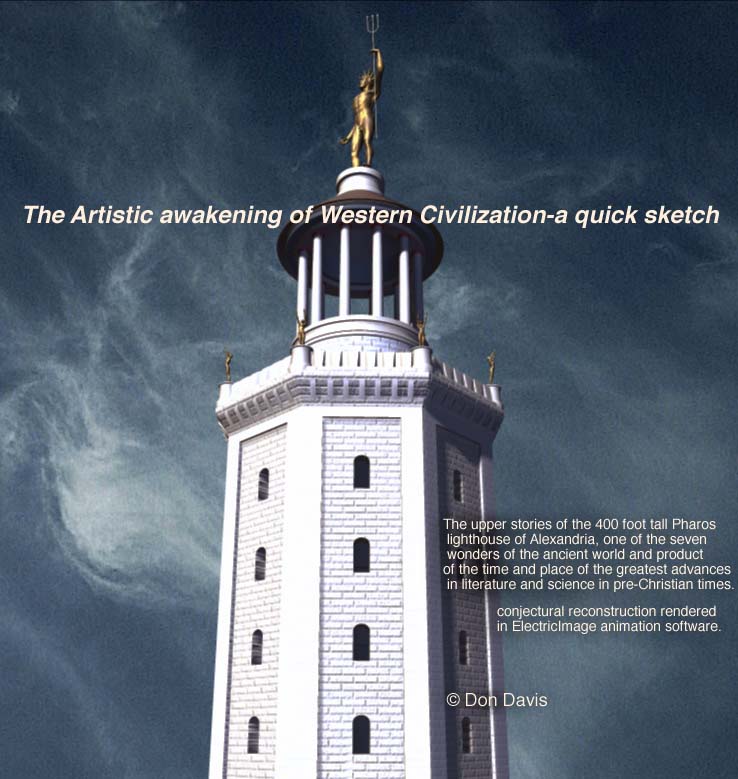

text and some images © Don Davis
A short summary
of the emergence of representational, or 'realistic' art provides
a sense of context to the kind of painting I grew to love. The
painting of real but exotic subjects I specialize in draws heavily
from centuries old techniques developed in preparing and applying
paint to attempt to create the illusion of another reality on
a flat surface.
This 'thumbnail sketch' of the rise, fall, and recovery
of representational painting is naturally limited in focus, the
measuring of standards linked to the skill of imitating life's
appearances. However much this ignores other worthy artistic traditions
this quick summary highlights overall patterns in human progress
and perception relevant to understanding and painting nature.
There are trends and processes in civilization affecting our ability
to learn of these things that we ignore to our peril. The story
of when we started to want to know is one vital aspect of the
past, another is the process of the decline of literacy and the
loss of most of the written and especially pictorial material.
Among the grand lessons we are left with is the need to treasure
our heritage of knowledge and keep it alive and renewed.
A brief survey of the beginning of 'realistic' portrayal
is given partly because it gives a window into the emergence of
Western civilization and also because all that is left of this
history is a few tattered but digestible scraps. May we never
have to be reconstructed from such sparse, shredded remains. Of
the heritage of literature which has enriched human progress in
its various ages prior to the invention of the printing press
perhaps .001 percent has come down to us in whole. such loose
bits of pages caught from the winds of time are all we know of
many of the artists mentioned below.
The extension of human experience
through literature, sculpture, and painting is as old as civilization.
The deliberate painting of images with the aim of skillfully emulating
reality began and first blossomed with the Greeks, in whose images
and writings can be seen much of the awakened perceptions and
skills of humanity.
Sometime in the opening centuries of the First Millennium
B.C. the creative spark was lit, with attempts to recreate subjects
in two and three dimensional methods accompanying their analysis.
The refinement of the tracing of a person's
shadow is said to be the start of Greek Painting. Philokles
the Egyptian and Kleanthes of Corinth are mentioned in connection
of this stage of the art, presumably building upon the artistic
traditions of ancient Egyptian monumental works. The names and
dates I give here are done sparingly, as it rapidly clutters things
however in the case of the first realist painters this and a few
words about their careers is all we have. The innovation of placing
lines within the outlines to suggest surface contours is credited
to Aridikes the Corinthian and Telephanes the Sikyonian. Next
came filling in outlined areas with 'ground clay' color, it is
said by by Ekphantos of Corinth, with more names emerging in surviving
references as painting steadily grows in importance. In roughly
710 B.C. a battle scene painted by an otherwise unknown artist
named Boularchos bought it's weight in gold.
Human inquiry was by then steadily and successfully
delving into natural phenomena even as our ability to share perceptions
of things in literature and painting evolved.
A widely heralded benchmark in human understanding
of the heavens occurred in 585 B.C., when the earliest of the
great Greek Philosophers Thales of Miletus predicted a total eclipse
of the Sun, which stopped a battle between the Lydeans and the
Medes in it's tracks! Artistic breakthroughs were mounting. By
525 B.C. or so the artist Kimon of Kleonai was painting three
quarter views of people, and showing more articulation and variety
of views of his figures than anyone before. Painted drapery was
one of his innovations, a feature which became characteristic
of Classical art.
Polygnotos of Thasos, active around
420 B.C. was esteemed in his abilities to paint animated faces
with open mouths and teeth, and delicate transparent drapery.
His device for suggesting depth between groups of figures was
to place more distant people higher, as if on a steep hill, with
no obvious size reduction with distance. Another work mentioned
of Polygnotos is the aftermath of Oydssius's revenge on the gang
who moved into his household in his absence. Mikon of Athens
is another giant of that era, famed for battle scenes and mythological
works. He collaborated with Polygnotos on paintings for various
public shrines in Athens. Painted vases of the time mirror his
influence, giving at least a truncated summary of ideas being
explored in wonderful panel paintings which have since utterly
perished. Other great artists names have come down to us,
as that of Apollodoros of Athens who revolutionized the portrayal
of light and shadows, the coming giants of Greek painting building
upon his innovations.
Zeuxis of Herakleia flourished in the early
400's B.C., of whom it was said "He stole the art from his
very teachers and carried it off with him" Strong modeling
in light and shade and articulated poses are probably characteristics
of the work of Zeuxis. A Centaur family group was among his most
admired works, of which laudatory Roman accounts are all that
survive. It is fascinating to read Lucian's description of this
painting and try to imagine the original. The Roman general Sulla
was taking this work to Italy on a ship which sank while rounding
Cape Malea. (I hope the wreck is found and the presumably well
wrapped painting somehow found to be recoverable!)
Besides the breakthroughs in the imitation of
reality, the early to middle 400's B.C. also marked the first
studies of the principals of perspective and how to use them in
creating illusionist paintings of architectural subjects on a
flat surface. A painted backdrop for a tragedy by Aeschylus is
specifically mentioned as a celebrated debut of perspective rendering,
with other authors commenting on a work by Agartharchos describing
how parallel edges of buildings will conform to converging lines
drawn to distant eye level points. Agartharchos was a contemporary
of Zeuxis, and he formulated and published a work on the principals
of what in Greek was named 'Skenographica', which translates as
'scene painting'.
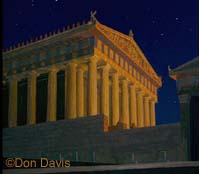
The Parthenon statues were carved in
the 440's and 430's B.C., supervised by the master sculptor Phedias.
His principal claim to fame was a series of colossal cult statues
in and around some celebrated Greek temples. Athena was a subject
he tackled magnificently a number of times, the most prominent
example being the 'Lemnian Athena' which stood atop the Athenian
Acropolis. The golden glint from her helmet could be seen as a
distinctive glare by ships a good distance away. His 33 foot tall
Athena Parthenos stood nearby within the Parthenon. She towered
between two tiers of interior columns lining the Parthenon's 40
foot high room, standing on an elaborately carved pedestal behind
a shallow reflecting pool.
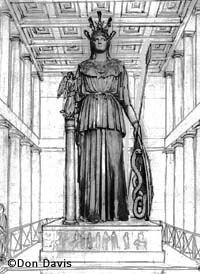 This elaborate
statue had clothing of gold and flesh of carved ivory. As one
entered the temple, whatever lighting was provided by doors, windows,
or torches would cause the gold highlights to gleam in the cavernous
depths, with the ivory softly glowing and the many jewels in portions
of the statues decorations catching the light as one moved. Athena's
left hand rested on an elaborately carved shield with a tall spear
supported between the fingers, the other hand was outstretched,
holding a life size statue of a winged woman. The Goddess's head
was topped by a tall triple crested helmet, bearing griffins and
rearing horses topped by flowing plumes.
This elaborate
statue had clothing of gold and flesh of carved ivory. As one
entered the temple, whatever lighting was provided by doors, windows,
or torches would cause the gold highlights to gleam in the cavernous
depths, with the ivory softly glowing and the many jewels in portions
of the statues decorations catching the light as one moved. Athena's
left hand rested on an elaborately carved shield with a tall spear
supported between the fingers, the other hand was outstretched,
holding a life size statue of a winged woman. The Goddess's head
was topped by a tall triple crested helmet, bearing griffins and
rearing horses topped by flowing plumes.
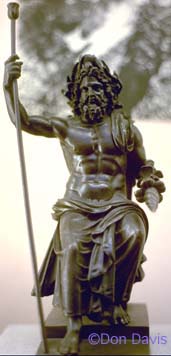 Despite the fame of this
and other statues of Athena which emerged from his workshop, the
acknowledged masterpiece of Phedias became his later seated figure
of Zeus in the temple at Olympia, this work making the list of
the seven wonders of the ancient world. Situated within a Greek
temple like the Athena Parthenos, but seated on an elaborately
decorated throne, Zeus held a vertical staff in the one hand and
a statue of a winged female on the other. The scale of the statue
was such that Zeus could not have stood up in his room! The majesty
of this bearded god figure inspired generations of visitors, and
was echoed in numerous derivative works. Many a coin and flattering
emperor portrait for centuries to come bore abbreviated echoes
of Phedia's Olympian Zeus.
Despite the fame of this
and other statues of Athena which emerged from his workshop, the
acknowledged masterpiece of Phedias became his later seated figure
of Zeus in the temple at Olympia, this work making the list of
the seven wonders of the ancient world. Situated within a Greek
temple like the Athena Parthenos, but seated on an elaborately
decorated throne, Zeus held a vertical staff in the one hand and
a statue of a winged female on the other. The scale of the statue
was such that Zeus could not have stood up in his room! The majesty
of this bearded god figure inspired generations of visitors, and
was echoed in numerous derivative works. Many a coin and flattering
emperor portrait for centuries to come bore abbreviated echoes
of Phedia's Olympian Zeus.
Between roughly 480 B.C. and the rise of the
Roman Empire (early 100's B.C.), painting attained great heights
along with statuary and architecture, establishing levels not
surpassed until perhaps the 1500's. Clues to the artistic abilities
of the Classical painters are found in the few surviving pre Christian
art essays, widely dispersed scraps of images done on durable
media, and reworking of classical themes by 'mass production'
painters on walls in Rome, Pompeii and Herculaneum. A standard
palette of colors for the artists of that time was one using only
white, yellow, red, and black, although blue appeared in building
decorations.
Around the early 300's B.C. Eupompos was an
influential artist, known for among other things a painting of
a victor of an athletic contest holding a palm branch. When a
smith in a bronze foundry with artistic aspirations asked Eupompos
what earlier painter influenced him, he pointed to a crowd and
said "Follow Nature, not another artist!". This inquirer
was Lysippos of Sikyon, who was then inspired to produce great
works of sculpture, especially under the later patronage of Alexander
the Great. Eupompos taught another important artist, Pamphilos,
who was the first painter "erudite in all branches of knowledge,
especially arithmetic and geometry, without which an art could
not be perfected". One student of Pamphilos turned out to
be Apelles of Kos, the most influential of the artistic giants
of the Ancient World. As part of Phamphilos legacy, from his time
on drawing lessons were made a part of the educational curriculum
of the times.
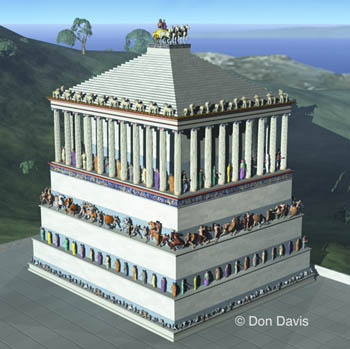
One major project by the great statue
carvers of that time were the numerous sculptural adornments for
the tomb of King Mausolos of Caria, who died about 353 B.C. The
Mausoleum of Halikarnassos was a fairly tall and narrow structure
roughly 45 meters tall, nearly half of which was a tall stepped
pedestal adorned with carved battle scenes and portrait statues.
Atop this stood a unique Greek style columned temple supporting
a modest pyramid. Columns completely surrounded the narrower core
building atop the main platform, the columns actually supporting
the edges of the pyramid. The bright sky glaring in the empty
spaces between the statues and columns gave the pyramid the appearance
of partially floating on air. Many statues on the monument were
made by several leading sculptors, including Skopas, Bryaxis,
Timotheos, and Leochares. Atop the tall pyramid was a sculptured
group portrait in a horse drawn chariot. This splendid buildings
fame resulted in its making the list of the seven wonders of the
ancient world. In time the very name of King Mausolos
became identified over the ages with elaborate tombs.
At roughly 350 B.C. the muralist Nikomachos
painted in a loosely expressive yet clear and realistic manner.
Once he took a big commission from Aristratos, tyrant of Sikyon,
to be finished at a predetermined date. When the artist arrived
at the site just days before the dedication of the monument his
works were to grace, the tyrant was beside himself and full of
dire threats. Nikomachos, rising to the occasion, swiftly finished
off the work with remarkable speed and skill!
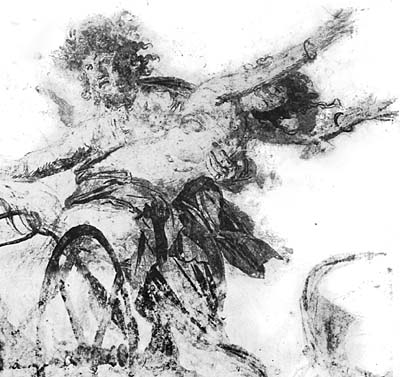
A tomb of suggested association with Philip of Macedon, Alexander's father, bears a fresco of 'The rape of Persephone', which may be an example or imitation of the style of Nikomachos. This work bears a feel of spontaneous execution. Every stroke seems to count as it is dashed off yet the flighty airborne nature of the scene of the god in flight is served well by this technique.
Below is a mosaic possibly based on the same prototype image as the tomb art.
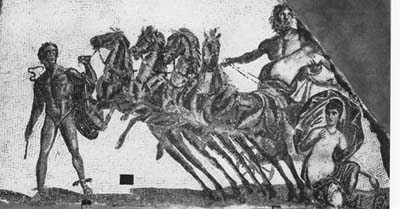
The greatest ancient painters arose
during the era of widest expansion of Hellenic influence, and
at the start of the Ancient World's most learned times.
Among the ancient world's
painters the reputation of one name echoes above all others across
the dark canyons of time, and sadly only his reputation and none
of his works have survived. Apelles of Kos bears the aura of a
Michelangelo of his times, supreme in all developments of painting.
He was active during the time of Alexander the Great, who in fact
was so enamored by Apelles expressive abilities that he decreed
that his portrait be painted by none other, while only Lysippos
of Sikyon may sculpt him. Popular expressions sprang from incidents
in the life of Apelles, including his daily practice of drawing
a straight line to keep his hand attuned, reflected in the saying
"Never a day without a line" Quoting Pliny, Apelles
"used to place finished works in a shop in views of passers-by,
and hiding behind a panel, he would listen attentively to the
faults that they pointed out, holding that the public was a more
astute judge than himself. It was said he was criticized by a
shoemaker because he had made one too few lace-holes in the sandals,
and that on the following day, the same man, proud that a correction
had been made on the basis of his previous criticism, made fun
of the leg, whereupon the artist peered out and denounced him,
saying a shoemaker should not presume to judge anything higher
than a sandal."
This saying then became a widely used proverb.
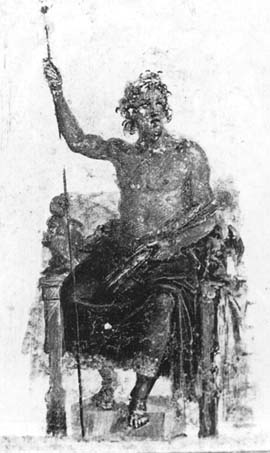
Apelles painted with startling reality,
including among the teams of horses and portraits of his heroic
pictures the effects of making things appear to 'come out of the
picture', such as in a famous painting of Alexander the Great
holding a thunderbolt in an outstretched hand. This painting,
of which a probable copy survives in Pompeii, was displayed in
the rebuilt Temple of Artemis at Ephesus, another of the world's
seven wonders.
The respect which Alexander held for this greatest
of the ancient worlds artists was shown after Apelles had fallen
in love with one of his favorite concubines while painting a nude
of her. With all Alexander could have done to him he gave the
turn of events his blessing for Alexander, at least in that time
of his career, "was great in spirit and even greater in his
power over himself." An Apelles portrait of Aphrodite rising
from the sea, famous in its day, was likely modeled after her.
Apelles assisted and encouraged
the careers of other worthy artists, especially Protogenes of
Rhodes, distinguished by his paintings of ships but best known
for a portrait of Rhodian hero Lalysos. Hearing of this great
artist, Apelles went to Rhodes to visit his studio, and found
Protogenes absent but a large empty panel waiting on it's easel.
The elderly lady custodian asked whom should she say had paid
him a visit, Apelles picked up a brush, said "By this person"
and proceeded to paint a narrow very straight line across the
canvas! When Protogenes later returned and was shown the line,
he instantly recognized the famous steady hand of Apelles. He
then took another color and carefully painted an even finer line
within the borders of the first one. Secreting himself away, he
awaited Apelles reaction upon his return. Apelles, taxed to his
utmost, then split the previous two lines by a third extremely
finely applied line, upon which Protogones appeared and admitted
defeat. This simple painting was famous even among the more accomplished
works of antiquity.
The painting perished in a fire in Rome at 3 AD,
one of several disastrous conflagrations which destroyed so much
of the art of Greek antiquity the Romans loved to collect.
Apelles admired Protogenes's works, and even
assisted his friends flagging local popularity by purchasing a
collection of the artists work and spreading the word that he
was buying the paintings in order to sell them as his own! This
display awakened the Rhodians to appreciate their artist. Apelles
said of one great work of Protogenes that by every standard the
other artists painting achievements were either equal to his own
or superior, in all qualities but one-in knowing when to stop
working on a piece.
One famous painting of Protogenes had it's finishing
touches applied by chance.
Struggling over and over again to portray the foam at a panting
dog's mouth with accomplished brushwork, a sponge he kept removing
the painted attempts with was hurled in a fit of exasperation
at the troubling part of the picture. The artist was then amazed
that the colors he had just wiped off were replaced looking exactly
as he wanted!
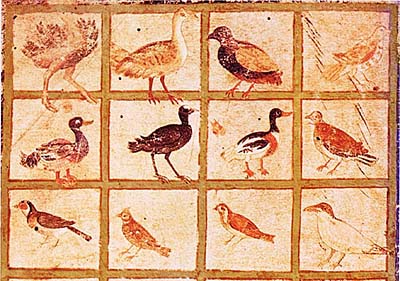 One industry which
promoted the existence of artists was that of book publishing.
Naturally a good copy of a book was a lengthy and exacting undertaking,
so much more was the execution of the initial editions of an illustrated
book, each copy being hand made from scratch! Many books were
done with more abbreviated drawings penned in, breaking up the
otherwise solid blocks of text. By todays standards very limited
editions of illustrated botanical and zoological books, among
many others, were circulated. One reference to a widely circulated
illustrated book mentions 700 portraits of famous authors painted
on the scrolls. The copying of such books in the hands of less
able artists than those who worked on the originals quickly lost
the initial distinctive style.
One industry which
promoted the existence of artists was that of book publishing.
Naturally a good copy of a book was a lengthy and exacting undertaking,
so much more was the execution of the initial editions of an illustrated
book, each copy being hand made from scratch! Many books were
done with more abbreviated drawings penned in, breaking up the
otherwise solid blocks of text. By todays standards very limited
editions of illustrated botanical and zoological books, among
many others, were circulated. One reference to a widely circulated
illustrated book mentions 700 portraits of famous authors painted
on the scrolls. The copying of such books in the hands of less
able artists than those who worked on the originals quickly lost
the initial distinctive style.
Above right is part of a page from a Classical era bird book, below is a partially restored wall painting from Pompeii.
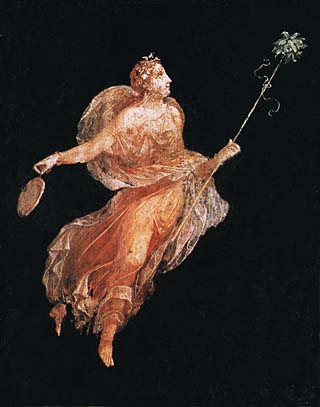
The influence of painting was widespread in Greek achievements and one area of art often enriched another. When the great sculptor Praxitiles was asked what statues of his he most valued, he replied "Those to which Nikias has applied his hand." Accustomed as we are to the weathered whiteness of the remaining traces, it is surprising to modern admirers of ancient statuary that the originals were skillfully painted so as to display both the clothing colors and the translucency of the marble simulating living skin. A protective light tan ocher coating of wax and pigment seems to have been applied to the overall marble surfaces of the major temples. Architectural decorations of Greek temples were brightly painted, with red generally used on horizontal linear detailing and blue the vertical, particularly on the 'Triglyphs' above the columns. The recessed moldings lining the edges of the ceilings above the long carved marble friezes were covered with delicately painted patterns. The friezes, lengthy stretches of carved figures and ceremonial elements, were also painted dark blue on the background plane with figures, horses, clothing and some background elements gaily colored. Metal attachments to statues were also common., with metal parts often used for weapons, horse rigging and reins, and such.
It was said of the Parthenon that
it appeared ancient from the moment it was created. The great
temples and works of art were doomed by the fame they attracted
in times far less enlightened than those they were created in.
The fortunes of these marble masterpieces wavered and declined
with that of the civilizations around them. At first flattering
but self serving adornments were placed on or around the temples,
like the shields placed below the 'Metopes' of the Parthenon by
Alexander, and statues and small shrines placed by various Roman
Emperors and dignitaries. The temples and sanctuaries were respected
and maintained for about 150 years as intended under the loving
maintenance of awed rulers and dedicated artisans. For more centuries
they braved periods of neglect, assimilation into other religions,
and widely separated catastrophes. At about 295 B.C. a local
tyrant named Lachares stripped off the 3/4 mm thick gold plating
from the wooden cores of the garments of the Athena Parthenos.
Later a thin layer of gold leaf was applied over the wood to regain
at least a superficial impression of the original. In about
the 250's B.C. major damage may have occurred to the Parthenon's
interior, perhaps requiring the rebuilding of the statue. Sometime
around the last years B.C. a terrible fire seems to have burned
out the eastern doorway and much of the interior. Again the sanctuary
was rebuilt and the Athena Parthenos replaced, as well as was
possible without the hand of Phedias. Finally maintenance ceased,
and after the sanctuary was emptied the weathering temple was
appropriated and remodeled for the use of religions of those who
later occupied the territory.
As the world unknowingly passed into what would
later be labeled the start of the first Millennium, the world's
population was some 250 million people. Although some extended
trade had existed for some time, several major civilizations existed
across the world practically ignorant of each others existence,
each with their far flung empires.
A trickle of trade between China and the West
along the 'Silk Route' seems to have begun not long after the
time of Alexander, but on a small scale unaccompanied by official
activities of any note. A distorting echo of Hellenistic realism
and decoration appeared in India in the wake of Alexander's conquests,
soon merging with the stylistic currents of that vast cultural
center of the world. Jungle empires in the Americas, South East
Asia, and sub-Saharan Africa created art and buildings within
complex cultures that thrived, ran their course, and died away.
Places with moist climates had a strike against them so far as
preservation of works of art and literature were concerned. Cultures
not developing intimidating weapons and defensive infrastructures
tended to fall victim to those that did, with the gap between
extremes growing by leaps and bounds over the centuries. The fatal
flaws of the leaders and societies of ancient times have long
been discussed regarding the causes of the declining state of
literacy and inquiry in the early centuries A.D. The existence
of the slave class has been cited as stifling interest in developing
labor saving machines, and the desire to learn more than the practical
minimum somehow withered under centuries of lack of initiative.
Perhaps the need for more than the basics of knowledge and the
means to bring it to many people are among the lessons we should
consider. So is the need to insure sufficient continuing interest
in such things.
Whatever the causes, by the start of what would
one day be known as the Christian Era things were already going
badly for knowledge and science. In 48 B.C. the fires of Julius
Caesar's burning of the Egyptian fleet spread to at least part
of the famous Alexandrian library. The other major Western literary
center of Pergamum was then raided of its books by Mark Anthony
in 40 B.C. to replace those of Alexandria.
Paintings and statues from the 'Greek Renaissance'
a few hundred years before were gathered by Roman trophy hunters
and later generations of art collectors, only to largely perish
in the great fires in Rome at 3, 64, and 80 AD. The 64 AD fire
was the celebrated occasion when Nero supposedly recited poetry
to the flames and dreamed of his opulently bloated 'Golden House'
to be built over the ashes. However statistically unhealthy it
was to be among Nero's immediate circle of acquaintances, he was
actually quite supportive of artists and even dabbled in painting
himself.
The conquering Romans fortunately revered Greek
artistic accomplishments, with widespread exhibition and copying
of plundered works aiding in the survival of at least echoes of
Greek artistic achievements. Most of the descriptions we have
of the great Greek works of art are from Roman authors separated
by as long a time from the pictures they admired as the Renaissance
artists are from our present vantage point at the start of the
21st Century.
In 105 AD, across the then unknown stretches
of Asia, the Chinese genius Tsu Ai Lun presented the first samples
of paper to the Emperor Ho Ti. Over the centuries following the
ebb of Western civilization this invention would spread across
the world to eventually replace papyrus and parchment as writing
materials. During the first few centuries of the Christian era
the ancient 'scroll' format book was steadily replaced by the
'codex' type book familiar to us today, with any part of the book
available by simply turning a page instead of the clumsy rolling
from one end of a papyrus roll to the other which plagued earlier
generations of the literate.
In the early to mid 100's A.D. Claudius Ptolemaeus
made and collected astronomical observations, wrote on various
subjects, and experimented with novel ways to project the sphere
of the Earth onto a flat surface. Two of his greatest works, the
'Syntaxis' (later known by the title distorted from the Arabic,
the 'Almagest') and the 'Geographica' assembled a wide picture
first of the methods and particulars of the body of knowledge
available to him, then the image of the known World with the first
atlas in the modern sense. Both of these works made the 'must
save' list and have come down to us basically complete, except
for pictures or maps.
A millennium and a half would pass during which the
influence of the writings of Ptolemaeus, or 'Ptolemy' was felt
among the small number of those who could read. His rather small
estimate if the Earth's circumference helped prompt the initial
attempt to cross the Atlantic Ocean in the much later Age of Exploration.
In the meantime the Ancient World was decaying and would languish
for centuries before slowly and painfully rebuilding itself.
The skills of portraiture routinely shown in
Emperor's busts and the like reveal a steady deterioration after
the late 200's AD, with the flexibility of figure movement so
well shown in the Greek works of half a millennium before steadily
losing their influence, replaced with stiffening effigies shorn
of the subtleties of their forebears. The artistic achievements
of the era of the Parthenon had long since passed through repeated
cycles of much imitated and copied stereotypes. The realism of
the newly created art seemingly waned along with the scope and
variety of the world view available to the artists of late Antiquity,
the images created during this time straddling the transition
between the Pagan and Christian worlds, with very different ideas
of life's meaning determining the kind of imagery in demand.
What survived of the skills of these times were such
activities as were constantly in practice, and literature was
to become low on most peoples priorities for a long time to come.
The base of knowledge ceased to be a living renewed process and
assumed the status of archives with portions gradually decaying
and disappearing.
A series of disastrous fires at collections of ancient
literature took place in Alexandria in 272 and 391, the first
during a Roman general's suppression of a revolt, the latter due
to a mob action led by the Bishop Theophilus against the nearby
Temple of Serapis, done with the 'blessings' of the Emperor Theodosius
I to consolidate the triumph of Christianity's influence in the
Empire. A catastrophic Mediterranean tsunami swept over Alexandria
on July 21, 365 which probably accelerated the decline of the
city after the initial devastation.
Emperor Valens ordered the burning of non Christian
literature in 373. Such episodes erased much of the opportunity
for art and science to systematically advance.
In 346 Atillas horse drawn armies pillaged their
way toward the Northern stretches of the Empire and helped drive
European tribes into Roman territory. A last major effort was
mounted against the invading Goths in 378, resulting in the utter
defeat of the Roman army and the killing of the Emperor Valens
himself. This burner of ancient literature was himself consumed,
it is said, in a fire as he and a few soldiers tried to hold out
in a small building surrounded by Gothic troops at first unaware
of whom they had trapped.
The decline accelerated thereafter as other
peoples fought their way to the gates of Rome itself, securing
huge tributes from the terrified inhabitants in blatant and repeated
extortion. By 395 the Roman Empire was divided into east and west
following the death of Emperor Theodosius I that year. The growing
importance of the city of Constantinople since its renaming (from
the ancient name Byzantium) was acknowledged by the Emperor Constantine
in 330 by making it the capitol of the Eastern Empire. A great
empire was split first into two, than many separate entities shuffling
themselves into what would someday be called Europe. In a little
forceable reshuffling of belief systems, Emperor Theodosius I
banned the practice of Pagan cults and closed their temples, after
heavy lobbying by the clergy.
Over time a significant portion of the ancient
world's remaining artistic and literary treasures found their
way to Constantinople. This great city became the bastion of ancient
Western tradition for many centuries to come. Sadly, the concentration
of many treasures so often becomes the last stage in their existence,
and in 403 the fire which destroyed the first Church of St. Sophia
also deprived future generations of numerous original Greek statues
displayed inside. Another fire, in 425, gutted the emptied interior
of the deserted Temple of the Olympian Zeus. Within a century
the nearby river changed course, which along with earthquakes
and landslides steadily erased the once holy site from local memory.
Later plundering of Rome itself by invaders,
such as the 'Sack of Rome' by Alaric and the Visigoths in and
that of the Vandals in 455 undoubtedly saw the destruction of
much of the remaining art in the old capitol. In the late 400's
the Athena Parthenos, or the twice rebuilt replacement, was removed
from it's temple and taken to Constantinople. A Wonder of the
World also long since taken to the city from it's temple, the
great statue of the Olympian Zeus by Phedias, stood the trials
of time and the indignity of abduction only to perish in a fire
in 462 which consumed the palace it was housed in. The accidental
or incidental loss of treasures of art and building took their
toll, but the worst blows against civilization were the repeated
deliberate efforts to destroy the gathered knowledge itself. These
were crimes against the past and present as well as the future.
Christian religious zeal can be credited
with much of what Carl Sagan termed a 'frontal lobotomy of Western
Civilization', after which progress had to painfully regather
itself from scratch in so many areas. Much of the lost history
can never be recovered. The end drama in the decline of Alexandrian
scholarship was the murder of it's last librarian, Hypatia, in
415. During a time of riots and counter riots a mob of monks,
henchmen, and Christian sympathetic rabble opportunistically incited
by the jealous rage of the local Archbishop Cyril grabbed her
from her chariot, stripped off first her cloths then her flesh,
and burned her remains.
Hardly any non religious works of art seem to
have been produced for a thousand years to come. The base of information
available to the shrinking educated class was itself becoming
tattered and scarce. Religious literature became the major written
materials in circulation among the very small minority who could
read. The plunging literacy rate was the most telling sign of
the decline of civilization, with the result of millions being
intellectually trapped in the limited worlds of their immediate
surroundings, cut off from the experiences of other peoples and
places except for the very few who traveled any distance. Increasing
destabilization of the frontiers of the crumbling Empire made
long voyages less likely. Laws were enacted by an increasingly
desperate Roman government keeping people living and working on
estates for generations. Much of the travel taking place from
the disintegrating empire was in the form of religious pilgrimages,
with little gathering of knowledge or even of good maps resulting.
The last western puppet Roman Emperor, Romulus
Augustulus, was deposed in 476 by the German army commander Odoacer.
Continuity of tradition and culture dissolved in the chaos, although
many more rural regions suffered less dramatic declines than popular
ideas of history suggest. Towns grew, families lived, and churches
were full. The old Gods and their monuments meant little to the
new generations, but some ancient images and buildings had their
grandeur appropriated by the propagandists of the new faith, with
the fate of the rest left to the elements. Only the durability
of the many marble copies of Greek statues made for rich Roman
clients up to that time allowed the survival of a few battered
remnants today, sadly paintings were far too fragile to bridge
the gulf of time and neglect.
What pictures survive from the next few centuries
generally show retreat from attempts at perspective or visualization
of volume, with picture areas often filled with drawings of almost
childlike naivete. Flattened formatted symbolism representing
people and places becomes more of a form of decoration than that
of portrayal. Years as we know them started being counted in 525
based on calculations, done in a time of shabby scholarship, by
Roman theologian Dionysus Exiguus. He did rather well with the
available resources, placing the date of the birth of the individual
known as Jesus Christ only about 4 or 5 years too late. (There
was no year zero, by the way).
In 529 Justinian closed the school of Philosophy
in Athens, which had been active for 1000 years. The counting
of time itself and the knowledge available to people were thus
reshaped by The Church. A massive eruption near Krakatoa at 535
lowered the temperatures worldwide for several years, and may
have driven nomadic warriors such as the Avars westwards from
their former Asiatic territories as the former grazing lands of
their horses withered away. They are credited, with some dispute,
with the invention of the stirrup which greatly enhanced the use
of horses in warfare. The Avars pressured a Byzantine Empire already
reeling from the debut in Europe of the first Bubonic Plague 'pandemic',
which may have been promoted by the cooler climate in the wake
of the massive eruption. Literacy declined drastically, with
decimation by plague contributing to Latin and Classical Greek
becoming nearly dead languages only a few educated monks could
read after the mid 500's.
Here and there amid the simplification and formatted
artistic styles of what we usually see from the Middle Ages are
seen isolated manuscripts still revealing classical influences
available to at least some artists of those days. Even in the
period of worst decline of civilization in the West, at about
800 AD, some widely scattered artists were aware of at least part
of the tradition of their artistic forebears. Numerous monasteries
kept the flame of literacy alive, with a few of the more interesting
classical texts being preserved by copying and recopying by hand,
a heroic and time consuming task. A Bible could take a year to
neatly write out, and many worthy works never excited the interests
of copyists to invest this effort. Many text fragments were accidentally
saved only because the old ink was scraped off and the scarce
parchment recycled, the faint traces of the earlier text revealing
themselves one day under careful scrutiny.
In the meantime conquest was added to decay
in disturbing what continuity existed in wide regions once within
the Eastern Roman empire. Another influential faith was to challenge
Christianity in the hearts of the people of the eastern Mediterranean
and ultimately in battlefields across Asia and Europe. For many
years, a large meteorite which had fallen in the Arabian desert
had been an object of veneration, draped in Coptic linen cloth
and adorned with poetry written in gold pages. In times to come
that meteorite would be set within the largest silver artifact
this spot would become the holiest place on the planet for untold
millions of people and form the nucleus of the most visited of
religious shrines. The period of wide expansion of Islam, beginning
at the death of Mohammed the Prophet in 632, pressured the scattered
remnants of European society to come to grips with the eastern
Mediterranean suddenly becoming part of a rapidly spreading religious
empire! Wherever the Moslems conquered, pictures and
statues were destroyed, as portraiture was frowned upon in the
Koran. The occupation of Alexandria in 642 by Caliph Omar I, second
of the successors of Mohammed, supposedly saw the final destruction
of the remaining books in that city. This often told story might
or might not be true, but over the centuries it has taken on a
life of it's own. An appeal to save the books was answered by
Omar as follows: "If the books contain the same doctrine
as the Koran they ought to be destroyed, since the Koran contains
all necessary truths; but if they contain anything contrary to
the Koran, they ought to be destroyed, therefore, whatever their
contents they must be burnt." So burnt they were, in Alexandria
where for six months they served as the fuel for the fires which
heated the numerous public baths.
At least some of the later generations of Islamic
conquerors, happily part of a literate culture, saw the value
of the knowledge gathered by the infidels in many practical matters
like Astronomy, Geography, and Medicine. Much of the ancient Greek
science exists today thanks to Arab sources, who preserved and
translated many works they came upon which would otherwise have
fallen into oblivion. Arab Science was the most progressive of
it's time, and may have by example served to awaken the West to
the value of knowledge and progress.
The ornate geometric decorations of the great
works of Islamic architecture revealed the flourishing of arts
under a non representational tradition.
In noting the major episodes of mass destruction
of art, within Christendom another deliberate attempt to erase
our creative heritage probably occurred in 727 when Pope Leo III,
the quintessential Iconoclast, during a dispute with the Byzantine
emperor commanded the destruction of 'religious pictures and statues'
in his realm.

Other contemporary cultures of which Europe was then ignorant were creating works of unsurpassed majesty, to be discovered by the West centuries after their formative civilizations had decayed. In 760 the carving was begun, under Krishna I, on the vast Kailasanatha temple at Ellora in India. This became, over the next 100 years, the greatest sculptural effort of all time as life size Elephants, ornate layers of decoration, and elaborately carved decorations in endlessly repeating patterns were chiseled from a mass of rock comparable in volume to the Parthenon.
Other decorative carvings in India
such as the carved marble interior of the Jain sanctuary at Mount
Abu in Rajputana seemingly surpass human ability in their microcosms
of symmetrical intricacy. (left)
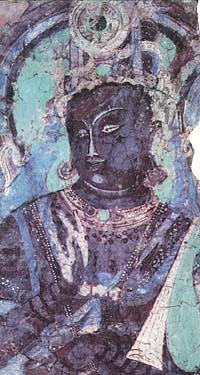
Intriguing scraps of the
images left by Indian and other Eastern cultures only make us
wish more had survived. The human race over the ages has worn
so many faces which such images can only hint at.(right)
Bit by bit, isolated expeditions
extended European experience outwards to touch new lands and eventually
other cultures. Those with the furthest reach at the time were
the Vikings. Lief Ericson is said to have landed in Nova Scotia
on the year1000.
That year an insubstantial but important invention
appeared, that of the Zero, by the Indian mathematician Sridhara.
Using zeros quietly revolutionized handling of larger numbers.
Among the things left behind in Europe in the wake of the recapture
of vast lands from Arab conquest as the first Millennium AD ended
were the Hindu-Arabic numbers now familiar to us, largely spreading
from the cultural center of Baghdad. Something as subtle as an
efficient numbering system would mean much in the long run. Big
numbers were quite laborious with the old Roman numeral system.
(although to this day movies still use Roman numerals in the end
credits!)
Speaking of numbers, as the big odometer of
the Christian calender turned over, for the first time since years
started being counted they would have 4 figures! Theologians
had a great subject for sermons as the Millennium mark approached,
but the amount of public apprehension that history was about to
end seems to be minimal. Progress here and there slowly began
to establish a cumulative trend. The decay of the old was replaced
in the opening centuries of the Second Millennium by the rebirth
of desire for working towards progress, in the case of representational
art starting almost from scratch.
During the turbulent 3 centuries between the
early 900's and the sack of 1204, much of the art remaining from
Classical Greece and Rome sequestered in Constantinople perished.
The majestic Athena Parthenos became a casualty of the fires and
riots. Another plundered work of Phedias, the bronze Athena which
once stood atop the Acropolis, was pulled down by a drunken mob
in 1203. Such was the fate of so many past treasures gathered
together into one place, only to be destroyed in periodic local
catastrophes. So it is to the present day.
Despite such losses to individual
masterpieces, the spark of ancient artistic attainment was never
completely extinguished, just adopted then adapted as triumphant
Christianity reached for the hearts of the public using widely
perceived visual symbolism to carry it's messages. Gradually
the old associations died away with their generations, leaving
the prototypical imagery to be embroidered and refined by later
artists. The straight nosed face of Christ, as portrayed by the
mosaics in Hagia Sophia in Constantinople at about 1200 may have
been based on the Zeus image made famous by Phedias and others
in the Classical tradition. The 'angels with wings' image has
it's prototype in Pre-Christian Greek and Roman art, as do representations
of people with little horns!
Armies of the Fourth Crusade sacked Constantinople
in 1204, wrecking and looting many of the remnants of art treasures
stored since Antiquity. The balance of power was upset in the
region, allowing steady Turkish movement into Asia Minor and the
Balkans, and finally the taking of the ancient city itself.
Early stirrings in the revitalization of drawing and
painting appear around the 1200's, the paintings within the Strausburg
Cathedral being an example. The sense of the third dimension begins
to creep back into pictures from this time on.
Sometime in the 1200's an earthquake toppled
much of the upper portions of the Mausoleum, which then stood
as an imposing ruin for over two centuries thereafter before being
mined for building materials and lime by an occupying force of
French knights. The source for much of the marble burned for lime
were the sculptures.
The great white marble tower of the Alexandrian
lighthouse also stood for over a thousand years, during which
it was the second tallest building in the World at nearly 400
feet tall (after the 'Cheops' pyramid at 444 feet). The great
lighthouse was largely toppled by earthquakes after centuries
of maintenance under Islamic custodians, with the upper story
remodeled as a Mosque.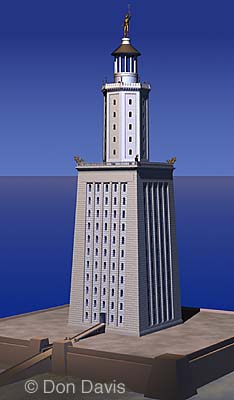
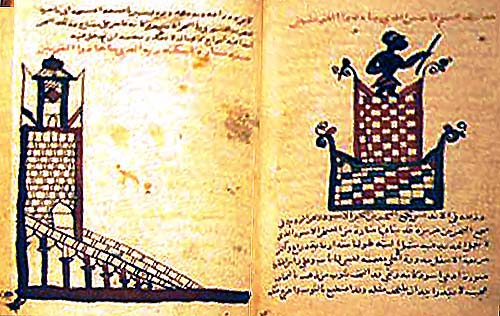 A drawing
of the Pharos has been found in an Arabic manuscript. On the left
page is a crude but informative sketch of the entire tower in
Islamic times complete with a Mosque's pointed dome on top. On
the right is a stylized sketch of the statues of the upper tower
in it's original form. Perhaps the writer had access to historical
materials we can only long for.
A drawing
of the Pharos has been found in an Arabic manuscript. On the left
page is a crude but informative sketch of the entire tower in
Islamic times complete with a Mosque's pointed dome on top. On
the right is a stylized sketch of the statues of the upper tower
in it's original form. Perhaps the writer had access to historical
materials we can only long for.
An 1166 account of the examination
of this building by an Arab tourist makes fascinating reading,
and provides our best description of the overall dimensions of
the decaying but still grand tower. Shortly afterwards the Pharos
was too ruined to enter. An earthquake in 1303 finished the job,
tumbling the tower into a mass of building stones which a century
later were used to build a fortress atop the base of the ancient
building.
Byzantine and older artistic influences soon
invigorated the pictures of the leading Italian artists as plundered
artworks and manuscripts were brought back by the crusaders.
Over the next two centuries, the use of shading
in portraiture suggesting illuminated shapes steadily established
itself almost like a mass realization was taking hold of the possibilities
of art, although for a short time the bodies were dealt with in
a flatter formalized fashion than the faces. A fresco done in
Constantinople about 1310 shows the advances in progress in composition
of pictures as well as in the skills of portrayal. As the 1300's
began, the work of Cimabue, Duccio, and Giotto really began to
break free of the iconography accumulated during the centuries
following the fall of Rome. Flesh, then cloth, and finally the
surroundings began to be painted with the portrayal driven by
the richness of real surroundings rather than the trappings of
tradition.
The Black Death devastated Europe and the Near
East through the middle of the 1300's, leaving grisly reminders
in the images of the art of the times as perhaps a third of the
population was carried off. Social attitudes were deeply destabilized
during the Plague years. The desire to learn the causes and prevention
of such scourges prompted the study of medicine and the rediscovery
of the virtues of sanitation. Secular thought began to accumulate
a picture of the World independent of the agendas of the Church,
despite the occasional martyrdom of prominent scientists as heretics.
Increasing inquiries into the frontiers of knowledge steadily
replacing referral to ancient recopied documents. In the end the
old bastions of social order simply became one of many voices
being heard and read. Reading is the key to staying aware of things
then as it is now.
By the 1400's the developments in art really
explode, and here my summary begins to taper off with the reader
referred at this point to the many books which quite capably take
up the story. Passing mention is due to the Dutch painters
who refined the subtleties of the art of painting in oils, and
the constant presence of Italian artistic expertise in pushing
the frontiers of painting to and beyond the levels of attainment
reached in antiquity. The first descriptions of the principals
of perspective drawing soon appeared, among them the 1412 work
of Filippo Brunelleschi. Thus another Classical era achievement
was recreated and surpassed.
Painting, although largely restricted in surviving
examples to religious subjects, reveals widening of perceptions
as well as skill from this time on.
An illuminated manuscript created about 1413
by the Limbourg Brothers, the "Les Tres Riches Heuers Du
Duc De Berry", is a wonderful collection of images showing
sights and ways of life which had changed little for centuries,
but were soon to vanish. For the first time in ages the world
one grew old in started to be increasingly different from that
which one was born into. The 1400's were graced with several
earth shaking discoveries and inventions, some which were to take
many years to make their significance known. Early in that century
China held the lead in world exploration, crossing the Indian
ocean to the East coast of Africa. China then abruptly withdrew
from the world at the verge of establishing shipping empires as
European nations did several decades later.
Gutenberg's premiere of printing books in the
1450's marks the first European use of movable type, a process
invented long before in Korea. Before long a book could be a widely
affordable item. The appearance of Gutenberg's famous edition
of the Bible occurred the same year as a catastrophic defeat on
the world stage for Christendom. After a lengthy siege the Turks
captured Constantinople in 1453, erasing the last continuous vestiges
of Greco-Roman civilization. This infamous seige included the
use of cannon to batter down the city walls which stood for a
millenium,This was a kind of 'Pearl Harbor' of it's day, shocking
and galvanizing the energies of an endangered West, which was
nurtured for centuries by Byzantium's will to survive. Five years
later the Turks took Athens, turning the Parthenon, which had
for centuries served as a converted Christian church, into a Mosque.
Back in poor Constantinople
injury would be added to insult when in 1509 a massive earthquake
leveled much of the city, furthering its rebuilding in the style
of the conquerors. By that time the literature burned in
the wake of the conquest, at least in the realm of Science, was
just reaching the point of being replaced and developed elsewhere
faster than it could be lost in any one place. In all perhaps
one in a thousand works of Classical literature managed to interest
generations of primarily clerical scribes in continuously copying
them for posterity.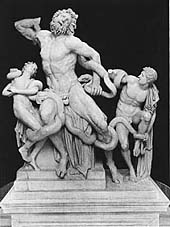
Easily 99.9 percent of all the art ever created has been destroyed, but some fortuitous finds at the right time impressed a world capable for the first time in over a millennium of appreciating them. Michelangelo was said to be present at a rare discovery of an ancient statue. This elaborate piece, previously known of through Pliny's writings, was in 1506 uncovered in Rome in the remains of Emperor Titus's palace. This statue group, known as the 'Laokoan group', portrays a high priest and his two sons struggling while being enwrapped by snakes sent by the gods as punishment for trying to warn the Trojans not to allow the gift of the famous horse into their city. This and other discoveries caused the remaining vestiges of ancient art to at last be treated as valuable, thereafter suffering only from clumsy restoration efforts and the work of professional thieves.
The Renaissance was as much
a desire to recapture Classical era standards of artistic beauty
as it was a move forwards. The realization of artists that they
were as capable as their Greek forebears, who first lit the flames
long left only smoldering in the hearts of generations during
the dark ages, came as knowledge of the world began to be readily
gathered and spread with the invention of printing. Any of the
scraps of Greek and Roman writings surviving until the later 1500's
suddenly became virtually immortal. Translations of Arabic
versions of various important ancient works allowed a respectable
summing up of available material on classical science. Firm foundations
then existed for later scholars to build on, although reverence
for ancient sources for a time became a bottleneck to the improvement
of knowledge. It again seemed to became a cultural fad in some
quarters to think of ancient writers as unattainably knowledgeable
or even divinely inspired.
Religious authorities often tried to stifle research
and experimentation, for a time causing Medical and Astronomical
studies to be clandestinely conducted. By then the cat was out
of the bag, and the rise of an educated and curious public brought
about a mass rethinking of the assumptions of what life was about,
and what was indeed knowable. The ancient past beckoned, not just
to be recaptured but to be outdone.
In 1492 the spherical nature of the Earth was
not only known but mapped as such. The first Earth globe manufactured
since antiquity was released that year by Martin Behaim of Nuremberg.
The truth of this idea was relied upon for the success of a daring
voyage by Christopher Columbus, who sailed Westward trusting Ptolomy's
rather lean estimate of the size of the Earth as well as some
favorable assumptions about the distances involved to help him
reach lucrative far Eastern ports. Columbus never found what he
had hoped for. His journeys would result in the establishment
of new countries as well as the decimation of the peoples and
cultures of that part of the World. Europeans, particularly the
Spaniards, moved in with superior weaponry and new diseases. The
literature and art of the Meso-American peoples soon perished
in another forced cultural lobotomy by representatives of Christianity.
The decline of slavery to come over the centuries liberated the
progress in the development of machines as well as the lives of
many individules.
The technology of war began to
destroy more efficiently, taking its toll of treasures as well
as targets. Some of the losses of Europe's Classical heritage
were heartbreakingly recent, such as the eviscerating 1687 explosion
suffered by the Parthenon during the retaking of the territory
from the Turks. Now the bleached bones of the colorful glory of
the past are all that remain, with clues to it's former glory
eagerly sought from minute study of the least weathered and shattered
remains. Of all the Seven Ancient Wonders only the Great Pyramid
would make it through the gauntlet of time largely intact, shorn
only of its smooth casing stones which were mined for local building
materials. Amid the petty wars of Europe's fledgling nation states
jockeying for position the realization that there was a lot more
to the World than we knew of steadily sank in. Just as shipbuilding
and seafaring abilities were developing to the point of making
such voyages possible there were suddenly new places to go.